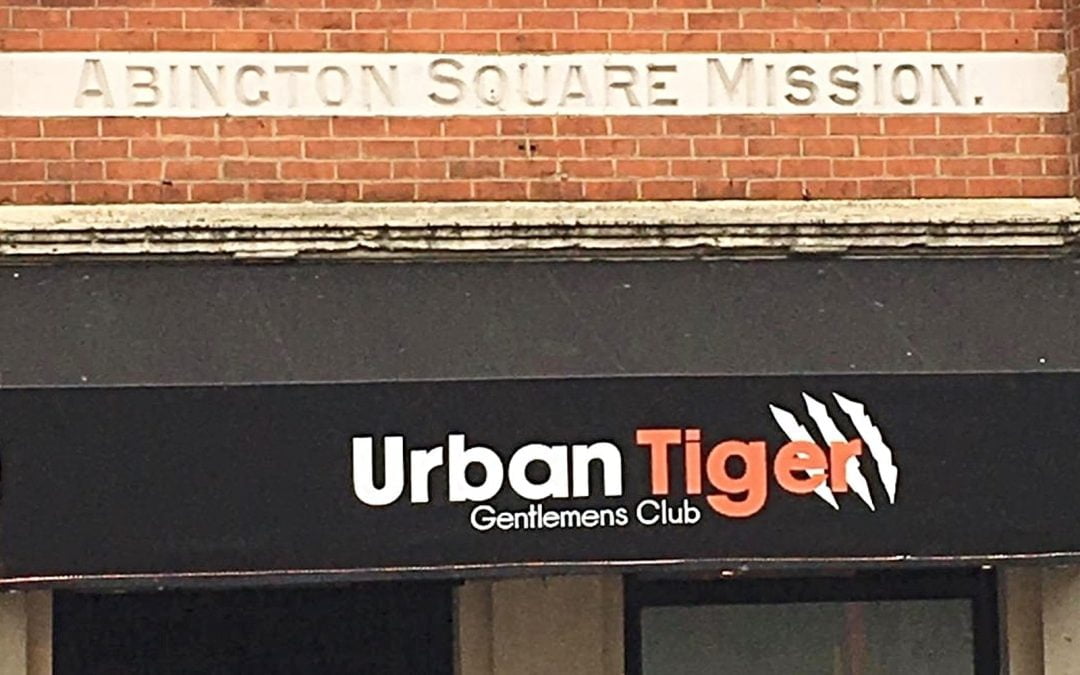The Rev E.T. Prust laid the foundation stone of Abington Square Mission in the center of Northampton, England, in July 1878.
The 1870s was an era when nonconformist missions made a massive impact in towns and cities in the United Kingdom.
As well as running Sunday services, many of these missions ran “ragged schools” to educate poorer children and where generations of working-class people found faith, community and shared purpose.
As the famous quote goes, the formation of the Labour Party “owed more to Methodism than it did to Marx.”
Two of my former employers – The Shaftesbury Society (originally called the Ragged School Union and now Livability) and the West London Mission – were two examples of this significant urban movement.
In 2019, the Abingdon Square Mission building is still there. Its name is still proudly etched in the brickwork.
But times have changed. Today, the building is home to Urban Tiger, which describes itself as the town’s “premier lap-dancing club.”
I am sure the owners of the club and its clientele find this change of use ironic and amusing. Prust must be spinning in his grave.
But let’s also remember the many who would have given time, money and energy to the establishing of the mission.
A building established to be an outpost of faith, hope and love into the community is now used to sell a commercialized sexual experience that exploits, cheapens and damages everyone involved. I think it’s tragic.
I don’t care desperately about preserving religious buildings. Two of the churches I have been part of have met in former pubs.
And the reality is that some church buildings become under-used and some need converting for other uses.
But this example is a prime spot in the middle of a busy town center. Right opposite, another church has opened a center in a converted shop. Further down the road, another church is being used as a night shelter for homeless people.
Rather than a buildings-preservation issue, this is actually an issue of mission and unity. Mission, the sharing in word and deed of hope in God, is what the church exists for. How united is the church in this commitment to reach people?
Time and again, I have seen denominations or Christian organizations choose to sell or lease buildings on a commercial basis to prop up activity elsewhere rather than build a partnership with others.
In doing so, they literally sell out on their responsibility to the local area.
I don’t know the history of this particular building, but if different decisions had been made, the Abingdon Square Mission could have been a vibrant center of contemporary Christian mission.
It could be a base for a new congregation, street pastors, Christian counseling, youth clubs or homeless people.
Whether through explicit means of preaching and teaching or through implicit means of social action, it could be the beacon of Christian hope it was built to be. Instead, it has become the opposite.
How do you avoid this?
Those with a responsibility for church buildings should reflect on the following:
- Uphold the true value of buildings.
When faced with decisions about the future, trustees and governance committees of Christian buildings should do all they can to hand over the use of these assets to groups that most embody the original purpose.
They should establish sale conditions around the future use to protect the building for Christian mission. Even if this limits the price they can get, it upholds the true value.
- The irrelevance of denominational labels.
Many younger Christians I speak to don’t even know what denomination their church is part of, as I’ve commented on previously.
What matters today is less the label and more the sense of community and purpose. Is the church a place where people learn of the life-changing message of God in an environment that coheres with that message?
Christian buildings should be put in the hands of those who have energy and purpose to use them well.
- Unity through action.
The problems and challenges of our communities put doctrinal differences into perspective.
This is why social action that reaches into the community, such as food banks, street pastors and night shelters, has been so effective in building unity. These initiatives are helping to break down the tribalism that is still rife within the church.
- Missional thinking.
Across the country, there are historic denominations that have large buildings but don’t have many people.
And there are vibrant churches with many people but with no buildings. Both tend to have strengths and weaknesses and often express their faith quite differently.
It is in mission and an outward focus where they can find common ground. The church desperately needs people who can bridge these worlds and forge effective missional partnerships.
These are the thinking and commitments that may stop church buildings being turned into strip clubs.
Editor’s note: A version of this article first appeared on Kuht’s blog, Grace + Truth. It is used with permission.
Jon Kuhrt is chief executive of West London Mission and a member of Streatham Baptist Church in South London.

